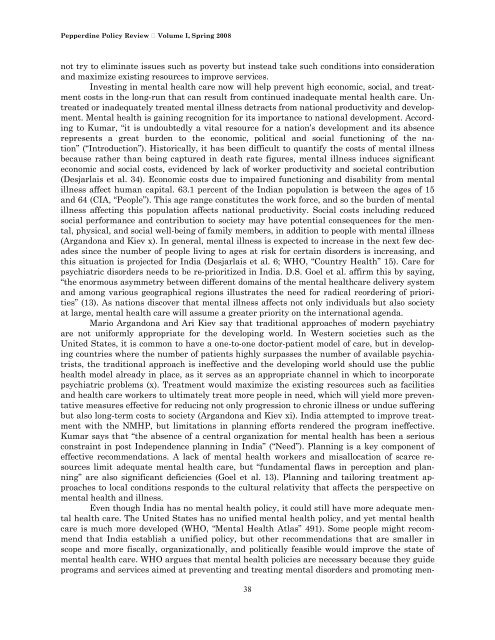Pepperdine University School of Public Policy
Pepperdine University School of Public Policy
Pepperdine University School of Public Policy
You also want an ePaper? Increase the reach of your titles
YUMPU automatically turns print PDFs into web optimized ePapers that Google loves.
<strong>Pepperdine</strong> <strong>Policy</strong> Review Volume I, Spring 2008<br />
not try to eliminate issues such as poverty but instead take such conditions into consideration<br />
and maximize existing resources to improve services.<br />
Investing in mental health care now will help prevent high economic, social, and treatment<br />
costs in the long-run that can result from continued inadequate mental health care. Untreated<br />
or inadequately treated mental illness detracts from national productivity and development.<br />
Mental health is gaining recognition for its importance to national development. According<br />
to Kumar, “it is undoubtedly a vital resource for a nation’s development and its absence<br />
represents a great burden to the economic, political and social functioning <strong>of</strong> the nation”<br />
(“Introduction”). Historically, it has been difficult to quantify the costs <strong>of</strong> mental illness<br />
because rather than being captured in death rate figures, mental illness induces significant<br />
economic and social costs, evidenced by lack <strong>of</strong> worker productivity and societal contribution<br />
(Desjarlais et al. 34). Economic costs due to impaired functioning and disability from mental<br />
illness affect human capital. 63.1 percent <strong>of</strong> the Indian population is between the ages <strong>of</strong> 15<br />
and 64 (CIA, “People”). This age range constitutes the work force, and so the burden <strong>of</strong> mental<br />
illness affecting this population affects national productivity. Social costs including reduced<br />
social performance and contribution to society may have potential consequences for the mental,<br />
physical, and social well-being <strong>of</strong> family members, in addition to people with mental illness<br />
(Argandona and Kiev x). In general, mental illness is expected to increase in the next few decades<br />
since the number <strong>of</strong> people living to ages at risk for certain disorders is increasing, and<br />
this situation is projected for India (Desjarlais et al. 6; WHO, “Country Health” 15). Care for<br />
psychiatric disorders needs to be re-prioritized in India. D.S. Goel et al. affirm this by saying,<br />
“the enormous asymmetry between different domains <strong>of</strong> the mental healthcare delivery system<br />
and among various geographical regions illustrates the need for radical reordering <strong>of</strong> priorities”<br />
(13). As nations discover that mental illness affects not only individuals but also society<br />
at large, mental health care will assume a greater priority on the international agenda.<br />
Mario Argandona and Ari Kiev say that traditional approaches <strong>of</strong> modern psychiatry<br />
are not uniformly appropriate for the developing world. In Western societies such as the<br />
United States, it is common to have a one-to-one doctor-patient model <strong>of</strong> care, but in developing<br />
countries where the number <strong>of</strong> patients highly surpasses the number <strong>of</strong> available psychiatrists,<br />
the traditional approach is ineffective and the developing world should use the public<br />
health model already in place, as it serves as an appropriate channel in which to incorporate<br />
psychiatric problems (x). Treatment would maximize the existing resources such as facilities<br />
and health care workers to ultimately treat more people in need, which will yield more preventative<br />
measures effective for reducing not only progression to chronic illness or undue suffering<br />
but also long-term costs to society (Argandona and Kiev xi). India attempted to improve treatment<br />
with the NMHP, but limitations in planning efforts rendered the program ineffective.<br />
Kumar says that “the absence <strong>of</strong> a central organization for mental health has been a serious<br />
constraint in post Independence planning in India” (“Need”). Planning is a key component <strong>of</strong><br />
effective recommendations. A lack <strong>of</strong> mental health workers and misallocation <strong>of</strong> scarce resources<br />
limit adequate mental health care, but “fundamental flaws in perception and planning”<br />
are also significant deficiencies (Goel et al. 13). Planning and tailoring treatment approaches<br />
to local conditions responds to the cultural relativity that affects the perspective on<br />
mental health and illness.<br />
Even though India has no mental health policy, it could still have more adequate mental<br />
health care. The United States has no unified mental health policy, and yet mental health<br />
care is much more developed (WHO, “Mental Health Atlas” 491). Some people might recommend<br />
that India establish a unified policy, but other recommendations that are smaller in<br />
scope and more fiscally, organizationally, and politically feasible would improve the state <strong>of</strong><br />
mental health care. WHO argues that mental health policies are necessary because they guide<br />
programs and services aimed at preventing and treating mental disorders and promoting men-<br />
38












